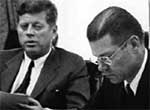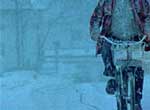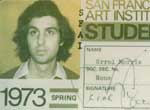By Michael Covino
Film Quarterly - Spring, 1980
Errol Morris's documentary about pet cemeteries is not about pet cemeteries, nor is it a documentary so much as a document about mainstream America at the crossroads in the late seventies. It is one of the most original films I have seen in years and also the most insidious, accomplishing something I would have thought impossible: it takes mediocre and vacuous middle-class Americans and makes them look mediocre and vacuous. I do not mean this in a facile sense. Any director who attempts such a film is obviously walking a tightrope, and in every scene, in every shot, is in danger of losing his balance. Morris never does. The film's project is not "exposing the pet cemetery racket," but still less does it exploit the eccentricities of pet lovers. The film rejects the more obvious and tasteful alternative of falsely humanizing its characters, and in so doing gains in aesthetic force what it surrenders in phony warmth. Gates of Heaven is appallingly funny, and appalling.
Still, it is a documentary about pet cemeteries, two California pet cemeteries - one on the verge of bankruptcy, another that is a modest success. Different sorts of people are interviewed: embalmers, renderers, people whose pets have just died, two sons going into their father's business which happens to be a pet cemetery. The people just talk. No interviewer appears directing the questions. The camera doesn't seem intent on capturing special "moments," or on recording people in action. In fact, there is little or no dramatic action (the most dramatic shot is of a young man mowing a lawn), no shaky, blurred or grainy images, no abrupt zooms, nothing is clumsily framed -the film has none of the usual signature shots of the documentary.
On the contrary, Morris serves notice almost immediately that he is up to something different. In the beginning we see a man in long shot standing beneath a tree: the voice-over that accompanies the shot provides information about a pet cemetery. There's a cut to the same man sitting in his house: he's dressed differently, a fat, red pen is clipped to the breast pocket of his crisp, brown shirt. The voice-over continues but it is no longer a voice-over -it has caught up with the man talking. And in this way it becomes clear that the usual direct sound recording common to documentaries will not necessarily be practiced, but instead the director will be using, when it suits him, the methods of displacement more common to fiction films. But, to be sure, the gains are more than a technical look of freshness. This will become evident.
No, this documentary doesn't look like a documentary. Just the opposite. Gates of Heaven is beautifully filmed and edited, and composed almost entirely of long, intercut monologues that manage to hold your interest, that are compelling not because what is being said is so fascinating, or absorbing, or informative (it almost never is), but because it is being said at all, in the manner in which it is being said. People speak English but is an English so imprecise, so inexpressive, so mangled, as to have lost all meaning. One woman speaks of establishing a deep and meaningful relationship with her poodle. A young man talks about the anxiety, the fear involved in trying to find the right exit off the expressway - a real ontological ordeal! - and he sounds like Kierkegaard after a bad head injury. These people stud the most improbable monologues, the most incredible soliloquies, with the demented vocabularies of the advertising agency, of the different consciousness and therapeutic and awareness movements, of the social science textbook and the pop psychology best seller, of the TV talk show and the secularized church. It's as though all the crazy argots of late twentieth-century American have congealed into one monstrous cake of fat, these people fry in their own conceptual habits. The movie-goer feels like he's occupying a listening post on the border of a foreign land inhabited by sad sacks and maniacs.
On and on it goes. Yet in contrast to the circumlocutory conversations, the camera angles are neutral with a vengeance - frontal medium close-ups, neither high nor low, with people usually talking straight into the camera while standing beneath a tree or sitting on an upholstered couch. Does this sound mundane? It is done so rarely in documentaries that the result is fresh and startling. It's a very descriptive film. The interiors look almost constructed: armchairs, ashtrays, sofas, vases, television sets - all props, and not one out of place. People sit in these spotless, carefully arranged living rooms that might well be show rooms in furniture-store display windows, and they discuss their dogs in the most ambitious fashions, but a rose - an American Beauty? - placed carefully in the foreground intrudes into the frame like some monstrous, ambulatory growth in a science fiction film. It's as though Norman Rockwell, whistling on the way to work, has bicycled with his easel and palette into The Twilight Zone. Has the film-maker cheated? Has he arranged things, perhaps even suggested to people what to wear? It doesn't matter. The painful artificiality of these interiors - I would say the social precision of these interiors - corresponds perfectly with the painful artificiality of the way these people talk. They might well have been sent over from central casting. More: the self-conscious artificiality of the camera work - as something apart from the "naturalistic" camera work of most documentaries - intensifies the general atmosphere of artificiality to such an excruciating degree that one can no longer ignore the artificiality, one becomes conscious of it. In living rooms like these, in homes like these, one really couldn't talk or think any other way. The movement of a single vase, the introduction of a single straightforward sentence, would shatter the fragile social shell, the delicate protective covering, in which these people live. It would make it impossible, at least momentarily, to hold at bay the fear and loneliness which is never really "held at bay," but which resides deep in the heart of the general Weltanschauung. But of course that would also be a start.
The film replaces the usual tension of documentaries with a new kind of tension: there's no Marcel Ophuls holding up a microphone to French collaborators and ex-Nazis, no Oriana Fallaci pursuing a tough line of questioning with some powerful head of state. No one's trying to evade anything. That's what's so depressing: it's the other way around. These very ordinary people are so innocent, so anxious, so eager to express themselves, to explain their "philosophies of life," A husband and a wife seem to discover in front of the camera that they have different theological notions with regards to the hereafter - the woman, at any rate, feels confident she will be reunited in heaven with her dead pet. (One cemetery owner underwrites these reunions.) A young man who helps run his father's pet cemetery business delivers a pep talk, a Dale Carnegie refresher course, on how to succeed in life. He describes how he advanced from salesman to sales manager, and you can really hear the italics in his voice: he's like a madman in a Thomas Bernhard novel. In his office he sits behind a desk that's covered with business trophies. It's not even a question of anticipatory set-ups: it's clearly a prearranged situation: this isn't documentary realism, it's movieland. No one works at a desk that cluttered with trophies - there's no room to work. But at least that much is self-evident. His monologue, on the other hand, is all too real. He explains that he likes interviewing job applicants in this office because he feels it inspires potential employees. They project themselves into his place. But at the same time he seems unaware that he himself is addressing the camera like a nervous young job applicant, like someone trying to get a purchase on life by expounding his own (hopefully) exemplary views. It's very funny at first. But a measure of the film's penetrative power is that every laugh boomerangs: after a while it's no longer funny.
Morris is a naif who has made an impolite movie: he doesn't seem to realize it's an unspoken rule that one's not supposed to show real people, ordinary people, looking so sad, so silly, so depressing. "He can't make fun of people like that. He's going too far," some will say, but they should have said of the others, "They haven't gone far enough." It's permissible to catch powerful people in lies, in contradictions, to show them for the megolomaniacs that they might be, or to elicit sympathy for the poor, the incarcerated, the deranged. There's a grammar for documentary film-making which Morris has ignored.
Yet it is not a contempt of "ordinary" people that the film displays, but a deep and unabiding contempt for the usual methods of documentary realism, a contempt for the quasi-aleatory methods of a cinema verite, certainly the dominant tendency of the sixties and seventies, that would pretend its "direct" methods do not interfere with the way events take place in reality, that would claim its methods discover what people are trying to hide, the cutting journalistic truths that never cut too deeply. Gates of Heaven doesn't look like anything but a manipulated picture of reality. (On the other hand, we learn only in retrospect how Flaherty reconstructed Nanook's igloo so that his camera could film its interior.) Its syntax runs counter to the usual documentary syntax. Its formalistic language, its tight and precise framing, its symmetrical compositions and, for the most part, static camera work, the careful cropping and insertion of photographs of (say) people's pets within the frame, the recurring visual motifs; all make it look more like a non-documentary film by Wenders, or Akerman, or Huillet and Straub. It's neither as frantic nor as personal as a documentary by Herzog; perhaps a film essay by Godard is its closest cousin.
And although the viewer knows that the most realistic-looking documentary is never objective; although the viewer understands that the investigative film-maker, when all is said and done, still selects footage and adopts a certain editing style; although the viewer accepts, begrudgingly perhaps, that nothing is ever as it really happened (pace Wiseman letting his unloaded camera stand around for several weeks so that his subjects grow "accustomed" to it); although the viewer knows all these things, he himself remains accustomed himself to viewing the realistic-looking documentary as though it were somehow real. Yet there is a paradox. The usual documentary, availing itself of the usual methods, trapping people in contradictions, capturing people during "privileged" moments, almost never - for all its apparent spontaneity - astonishes or overwhelms the viewer: General Westmoreland does believe the Vietnamese place no value on life (Hearts and Minds); Nazis are callous, even years later (The Sorrow and the Pity); poor people do lead difficult lives (from Man of Aran to Welfare). Various realities are presented approximately as the thoughtful viewer had imagined them, but precisely because these filmed realities conform to the viewer's conceptions, the films only serve to protect the viewer from a more comprehensive and disruptive grasp of reality.
Perhaps at one time such documentaries, with their jagged rawness, did seem to approximate reality in all its jagged rawness, but this no longer seems the case. Now they approximate nothing so much as - other documentaries. In contrast, a film like Gates of Heaven, which does not make a show of its "naturalness," achieves a far more startling degree of realness. The film lacks the usual shock absorbers. Despite its rigor, despite its formalism, despite its posing, despite its artificiality, despite all these things, Gates of Heaven overwhelms the viewer with the sheer, incredible horror of life as it often is in the quietest, most everyday moments. I say despite its, but I really mean because of; it should be clear that Morris hasn't actually ignored the grammar common to documentary film-making, but proceeded from an all too precise understanding of it.
For such a modest subject - pet cemeteries - the film achieves an astonishing depth. I think the gains of Morris's methods and artifices are apparent. But there is something else. Approximately two-thirds of the way through the movie, after a number of surreal interviews, an old woman named Florence delivers a long, brooding monologue: her beloved dog is dead, the neighborhood cat has vanished, and her only son - "no good" - almost never visits. It's her life story, not a very happy story, but neither especially unusual. But it's affecting, vivid, and the viewer suddenly finds himself - but with much preparation - in the presence of a pain, a sorrow, so naked and so powerful that all the film's artifice drops away, and the horror is out in the open, a horror which, up until this point, has been delicately held in balance by the acrid humor of the film. The story of this old woman, in the tritest, strictest and yet broadest sense, is the story of everyone.
It's an incredibly bleak film. The last image is a long, stationary shot of the cemetery at desk.
No people, no pets - just a long, forlorn shot of soft, green countryside. Everything is so quiet, so mournful. The image is held for perhaps thirty seconds. It blinks out.
Gates of Heaven
REVIEWS/ARTICLES
Todd McCarthy (Fog of War)
Fred Kaplan (Fog of War)
Samantha Power (Fog of War)
Ron Rosenbaum (Fog of War)
Kenneth Turan (Fog of War)
Peter Applebome (Mr. Death)
Ron Rosenbaum (Mr. Death)
Todd McCarthy (Fast, Cheap & Out of Control)
David Ansen (Fast, Cheap & Out of Control)
Roger Ebert (The Thin Blue Line)
Terrence Rafferty (The Thin Blue Line)
Janet Maslin (Vernon, Florida)
Alan Berger (Gates of Heaven)
Roger Ebert (Gates of Heaven)
MORE GATES
Synopsis
Watch Clip
Cemetery Maps
BUY THIS MOVIE
Criterion Collection
OTHER FILMS
Vernon, Florida
The Thin Blue Line
A Brief History of Time
Fast, Cheap & Out of Control
Mr. Death
The Fog of War
Standard Operating Procedure
Tabloid
The Unknown Known
The B-Side
Wormwood American Dharma






